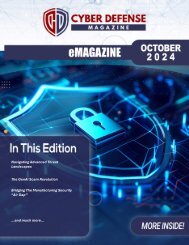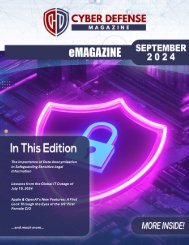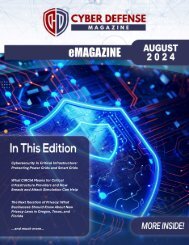Cyber Defense eMagazine December Edition for 2021
Will you stay one step ahead of Cyber Scrooge this year? Learn new ways to protect your family, job, company & data. December Cyber Defense eMagazine: Cyber Deception Month is here...Defeat Cyber Scrooge! Cyber Defense Magazine December Edition for 2021 in online format #CDM #CYBERDEFENSEMAG @CyberDefenseMag by @Miliefsky a world-renowned cyber security expert and the Publisher of Cyber Defense Magazine as part of the Cyber Defense Media Group as well as Yan Ross, US Editor-in-Chief, Pieruligi Paganini, International Editor-in-Chief and many more writers, partners and supporters who make this an awesome publication! Thank you all and to our readers! OSINT ROCKS! #CDM #CDMG #OSINT #CYBERSECURITY #INFOSEC #BEST #PRACTICES #TIPS #TECHNIQUES See you at RSA Conference 2022 - Our 10th Year Anniversary - Our 10th Year @RSAC #RSACONFERENCE #USA - Thank you so much!!! - Team CDMG CDMG is a Carbon Negative and Inclusive Media Group.
Will you stay one step ahead of Cyber Scrooge this year? Learn new ways to protect your family, job, company & data. December Cyber Defense eMagazine: Cyber Deception Month is here...Defeat Cyber Scrooge!
Cyber Defense Magazine December Edition for 2021 in online format #CDM #CYBERDEFENSEMAG @CyberDefenseMag by @Miliefsky a world-renowned cyber security expert and the Publisher of Cyber Defense Magazine as part of the Cyber Defense Media Group as well as Yan Ross, US Editor-in-Chief, Pieruligi Paganini, International Editor-in-Chief and many more writers, partners and supporters who make this an awesome publication! Thank you all and to our readers! OSINT ROCKS! #CDM #CDMG #OSINT #CYBERSECURITY #INFOSEC #BEST #PRACTICES #TIPS #TECHNIQUES
See you at RSA Conference 2022 - Our 10th Year Anniversary - Our 10th Year @RSAC #RSACONFERENCE #USA - Thank you so much!!! - Team CDMG
CDMG is a Carbon Negative and Inclusive Media Group.
You also want an ePaper? Increase the reach of your titles
YUMPU automatically turns print PDFs into web optimized ePapers that Google loves.
on channels like email. This starts with understanding the latest threats and building a cybersecurity<br />
culture around them.<br />
The State of Spear Phishing<br />
Who is being targeted and when?<br />
Tessian’s report found that the average employee receives 14 malicious emails per year, but that number<br />
jumps significantly <strong>for</strong> highly targeted industries. For example, retail employees received 49 malicious<br />
emails per year, while manufacturing employees received 31. Those sectors are also experiencing<br />
staffing shortages from The Great Resignation, leaving employees stressed, distracted and potentially<br />
more vulnerable to falling <strong>for</strong> a scam. These risks must be prioritized as companies navigate hiring and<br />
turnover challenges.<br />
Bad actors try to trick employees by sending malicious emails in the late afternoon, hoping to slip past a<br />
tired or distracted employee. The most common times <strong>for</strong> spear phishing emails to be sent was 2 p.m.<br />
and 6 p.m. Bad actors also take advantage of the holidays by offering “too good to be true” deals. The<br />
biggest spike in malicious emails came immediately be<strong>for</strong>e and after Black Friday.<br />
What’s the latest attack playbook?<br />
Impersonation techniques continue to be a go-to strategy in the spear phishing playbook. Tessian found<br />
that display name spoofing was the most common tactic, found in 19% of malicious emails. These attacks<br />
use deceptive display names on an email to mislead employees. For example, a display name might<br />
show the first and last name of the company's Chief Financial Officer requesting a wire transfer. While<br />
the email address itself may still look suspicious, a recipient often only looks at the name of the sender<br />
and could mistake it <strong>for</strong> a legitimate request.<br />
Domain impersonation, on the other hand, happens when bad actors secure a domain that looks like it<br />
belongs to a legitimate business. This technique was used in 11% of malicious emails. The brands most<br />
likely to be impersonated were Microsoft, ADP, Amazon, Adobe Sign and Zoom.<br />
What are bad actors after?<br />
Tessian’s analysis found that tricking users into downloading malware remains a common motive of<br />
phishing emails. Malicious links still prove to be a popular and effective technique, with almost half (44%)<br />
of malicious emails containing a URL.<br />
Our researchers found more emails related to wire transfers than credential theft, suggesting<br />
cybercriminals are still largely focused on financial gain. For example, they’re more likely to try to steal<br />
money by impersonating a vendor and requesting a payment than by posing as an IT person requesting<br />
an employee’s password.<br />
<strong>Cyber</strong> <strong>Defense</strong> <strong>eMagazine</strong> – <strong>December</strong> <strong>2021</strong> <strong>Edition</strong> 61<br />
Copyright © <strong>2021</strong>, <strong>Cyber</strong> <strong>Defense</strong> Magazine. All rights reserved worldwide.


















